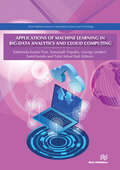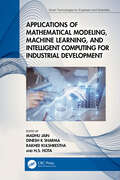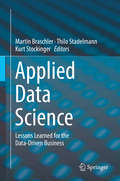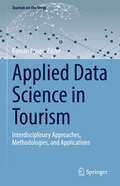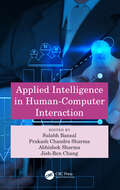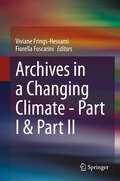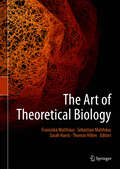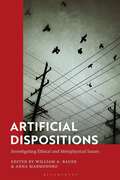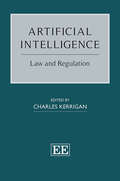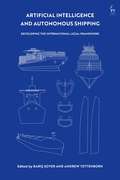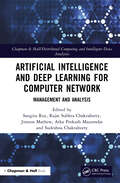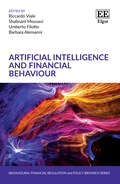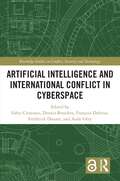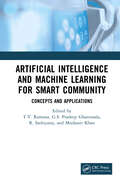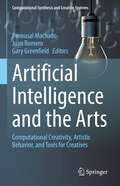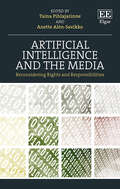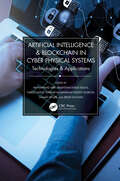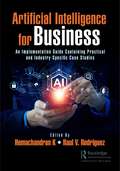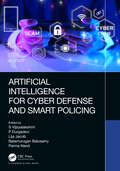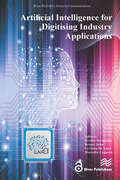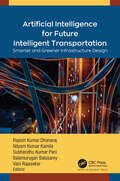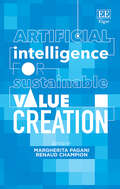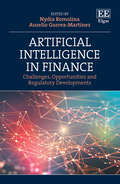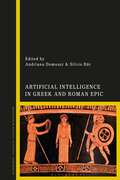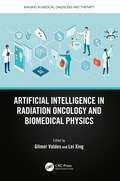- Table View
- List View
Applications of Machine Learning in Big-Data Analytics and Cloud Computing
Cloud Computing and Big Data technologies have become the new descriptors of the digital age. The global amount of digital data has increased more than nine times in volume in just five years and by 2030 its volume may reach a staggering 65 trillion gigabytes. This explosion of data has led to opportunities and transformation in various areas such as healthcare, enterprises, industrial manufacturing and transportation. New Cloud Computing and Big Data tools endow researchers and analysts with novel techniques and opportunities to collect, manage and analyze the vast quantities of data. In Cloud and Big Data Analytics, the two areas of Swarm Intelligence and Deep Learning are a developing type of Machine Learning techniques that show enormous potential for solving complex business problems. Deep Learning enables computers to analyze large quantities of unstructured and binary data and to deduce relationships without requiring specific models or programming instructions.This book introduces the state-of-the-art trends and advances in the use of Machine Learning in Cloud and Big Data Analytics. The book will serve as a reference for Data Scientists, systems architects, developers, new researchers and graduate level students in Computer and Data science. The book will describe the concepts necessary to understand current Machine Learning issues, challenges and possible solutions as well as upcoming trends in Big Data Analytics.
Applications of Mathematical Modeling, Machine Learning, and Intelligent Computing for Industrial Development (Smart Technologies for Engineers and Scientists)
The text focuses on mathematical modeling and applications of advanced techniques of machine learning, and artificial intelligence, including artificial neural networks, evolutionary computing, data mining, and fuzzy systems to solve performance and design issues more precisely. Intelligent computing encompasses technologies, algorithms, and models in providing effective and efficient solutions to a wide range of problems, including the airport’s intelligent safety system. It will serve as an ideal reference text for senior undergraduate, graduate students, and academic researchers in fields that include industrial engineering, manufacturing engineering, computer engineering, and mathematics. The book- Discusses mathematical modeling for traffic, sustainable supply chain, vehicular Ad-Hoc networks, and internet of things networks with intelligent gateways. Covers advanced machine learning, artificial intelligence, fuzzy sys- tems, evolutionary computing, and data mining techniques for real- world problems. Presents applications of mathematical models in chronic diseases such as kidney and coronary artery diseases. Highlights advances in mathematical modeling, strength, and benefits of machine learning and artificial intelligence, including driving goals, applicability, algorithms, and processes involved. Showcases emerging real-life topics on mathematical models, machine learning, and intelligent computing using an interdisciplinary approach. The text presents emerging real-life topics on mathematical models, machine learning, and intelligent computing in a single volume. It will serve as an ideal text for senior undergraduate students, graduate students, and researchers in diverse fields, including industrial and manufacturing engineering, computer engineering, and mathematics.
Applied Data Science: Lessons Learned for the Data-Driven Business
This book has two main goals: to define data science through the work of data scientists and their results, namely data products, while simultaneously providing the reader with relevant lessons learned from applied data science projects at the intersection of academia and industry. As such, it is not a replacement for a classical textbook (i.e., it does not elaborate on fundamentals of methods and principles described elsewhere), but systematically highlights the connection between theory, on the one hand, and its application in specific use cases, on the other. With these goals in mind, the book is divided into three parts: Part I pays tribute to the interdisciplinary nature of data science and provides a common understanding of data science terminology for readers with different backgrounds. These six chapters are geared towards drawing a consistent picture of data science and were predominantly written by the editors themselves. Part II then broadens the spectrum by presenting views and insights from diverse authors – some from academia and some from industry, ranging from financial to health and from manufacturing to e-commerce. Each of these chapters describes a fundamental principle, method or tool in data science by analyzing specific use cases and drawing concrete conclusions from them. The case studies presented, and the methods and tools applied, represent the nuts and bolts of data science. Finally, Part III was again written from the perspective of the editors and summarizes the lessons learned that have been distilled from the case studies in Part II. The section can be viewed as a meta-study on data science across a broad range of domains, viewpoints and fields. Moreover, it provides answers to the question of what the mission-critical factors for success in different data science undertakings are. The book targets professionals as well as students of data science: first, practicing data scientists in industry and academia who want to broaden their scope and expand their knowledge by drawing on the authors’ combined experience. Second, decision makers in businesses who face the challenge of creating or implementing a data-driven strategy and who want to learn from success stories spanning a range of industries. Third, students of data science who want to understand both the theoretical and practical aspects of data science, vetted by real-world case studies at the intersection of academia and industry.
Applied Data Science in Tourism: Interdisciplinary Approaches, Methodologies, and Applications (Tourism on the Verge)
Access to large data sets has led to a paradigm shift in the tourism research landscape. Big data is enabling a new form of knowledge gain, while at the same time shaking the epistemological foundations and requiring new methods and analysis approaches. It allows for interdisciplinary cooperation between computer sciences and social and economic sciences, and complements the traditional research approaches. This book provides a broad basis for the practical application of data science approaches such as machine learning, text mining, social network analysis, and many more, which are essential for interdisciplinary tourism research. Each method is presented in principle, viewed analytically, and its advantages and disadvantages are weighed up and typical fields of application are presented. The correct methodical application is presented with a "how-to" approach, together with code examples, allowing a wider reader base including researchers, practitioners, and students entering the field. The book is a very well-structured introduction to data science – not only in tourism – and its methodological foundations, accompanied by well-chosen practical cases. It underlines an important insight: data are only representations of reality, you need methodological skills and domain background to derive knowledge from them - Hannes Werthner, Vienna University of Technology Roman Egger has accomplished a difficult but necessary task: make clear how data science can practically support and foster travel and tourism research and applications. The book offers a well-taught collection of chapters giving a comprehensive and deep account of AI and data science for tourism - Francesco Ricci, Free University of Bozen-Bolzano This well-structured and easy-to-read book provides a comprehensive overview of data science in tourism. It contributes largely to the methodological repository beyond traditional methods. - Rob Law, University of Macau
Applied Intelligence in Human-Computer Interaction
The text comprehensively discusses the fundamental aspects of human– computer interaction, and applications of artificial intelligence in diverse areas including disaster management, smart infrastructures, and healthcare. It employs a solution-based approach in which recent methods and algorithms are used for identifying solutions to real-life problems. This book: • Discusses the application of artificial intelligence in the areas of user interface development, computing power analysis, and data management. • Uses recent methods/algorithms to present solution-based approaches to real-life problems in different sectors. • Showcases the applications of artificial intelligence and automation techniques to respond to disaster situations. • Covers important topics such as smart intelligence learning, interactive multimedia systems, and modern communication systems. • Highlights the importance of artificial intelligence for smart industrial automation and systems intelligence. The book elaborates on the application of artificial intelligence in user interface development, computing power analysis, and data management. It explores the use of human–computer interaction for intelligence signal and image processing techniques. The text covers important concepts such as modern communication systems, smart industrial automation, interactive multimedia systems, and machine learning interface for the internet of things. It will serve as an ideal text for senior undergraduates, and graduate students in the fields of electrical engineering, electronics and communication engineering, computer engineering, and information technology.
Archives in a Changing Climate - Part I & Part II
This book contains the first and second volume papers from the 8th International Conference on the History of Records and Archives (I-CHORA 8). Contributors present articles that propose new solutions and aspirations for a new era in the technology of archives and recordkeeping. Topics cover rethinking the role played by archivists, and reframing recordkeeping practices that focus on the rights of the subjects of the records. This text appeals to students, researchers and professionals in the field. Previously published in: Archival Science: "Special Issue: Archives in a Changing Climate - Part I" and "Archives in a Changing Climate - Part II"Chapter "Displaced archives": proposing a research agenda is available open access under a Creative Commons Attribution 4.0 International License via link.springer.com.
The Art of Theoretical Biology
This beautifully crafted book collects images, which were created during the process of research in all fields of theoretical biology. Data analysis, numerical treatment of a model, or simulation results yield stunning images, which represent pieces of art just by themselves. The approach of the book is to present for each piece of visualization a lucid synopsis of the scientific background as well as an outline of the artistic vision.
Artificial Dispositions: Investigating Ethical and Metaphysical Issues
We inhabit a world not only full of natural dispositions independent of human design, but also artificial dispositions created by our technological prowess. How do these dispositions, found in automation, computation, and artificial intelligence applications, differ metaphysically from their natural counterparts? This collection investigates artificial dispositions: what they are, the roles they play in artificial systems, and how they impact our understanding of the nature of reality, the structure of minds, and the ethics of emerging technologies. It is divided into four parts covering the following interconnected themes: (i) Artificial and Natural Dispositions, (ii) Artificial Systems and Their Dispositions, (iii) Agency, Mind, and Artificial Dispositions, and (iv) Artificial Moral Dispositions. This is a groundbreaking and thought-provoking resource for any student or scholar of philosophy of science, contemporary metaphysics, applied ethics, philosophy of mind, and philosophy of technology.
Artificial Intelligence: Law and Regulation
This timely book provides an extensive overview and analysis of the law and regulation as it applies to the technology and uses of Artificial Intelligence (AI). It examines the human and ethical concerns associated with the technology, the history of AI and AI in commercial contexts.Written by outstanding lawyers, technologists and other professionals, this book will help readers acquire an understanding of the taxonomy of AI, the legal rules that apply to AI and the way AI has been utilised in various commercial contexts.Key features include:explanation of the technology and practical legal issues relating to the use of AIexploration of AI in the traditional legal categories; including contract and tort lawchapters written by procurement, legaltech, algorithm auditing and other professionalsuse cases from the main industries utilising the technology, such as financial services, real estate and insurance.Artificial Intelligence will help to further readers’ engagement with AI and enable them to ask themselves the right questions while doing so. It will prove a crucial reference point for all lawyers, policy makers and academics with an interest in the interaction between law and AI, and to any lawyer with clients that use or consider using AI in their business.
Artificial Intelligence and Autonomous Shipping: Developing the International Legal Framework
This collection of essays critically evaluates the legal framework necessary for the use of autonomous ships in international waters. The work is divided into three parts:Part 1 evaluates how far national shipping regulation, and the public international law background that lies behind it, may need modification and updating to accommodate the use of autonomous ships on international voyages. Part 2 deals with private law and insurance issues such as collision and pollution liability, salvage, limitation of liability and allocation of risk between carrier and cargo interests. Part 3 analyses international convention regimes dealing with maritime safety and other matters, arguing for specific changes in the existing conventions such as SOLAS and MARPOL, which would provide the international framework that is necessary for putting autonomous ships into commercial use. The book also takes the view that amendment of international conventions is important in the case of liability issues, arguing that leaving such matters to national law, particularly issues concerning product liability, could not only restrict or hinder the availability of liability insurance but also hamper the development of technology in this field.Written by internationally-known experts in their respective areas, the book offers a holistic approach to the debate on autonomous ships and makes a timely and important contribution to the literature.
Artificial Intelligence and Deep Learning for Computer Network: Management and Analysis (Chapman & Hall/Distributed Computing and Intelligent Data Analytics)
Artificial Intelligence and Deep Learning for Computer Network: Management and Analysis aims to systematically collect quality research spanning AI, ML, and deep learning (DL) applications to diverse sub-topics of computer networks, communications, and security, under a single cover. It also aspires to provide more insights on the applicability of the theoretical similitudes, otherwise a rarity in many such books. Features: A diverse collection of important and cutting-edge topics covered in a single volume. Several chapters on cybersecurity, an extremely active research area. Recent research results from leading researchers and some pointers to future advancements in methodology. Detailed experimental results obtained from standard data sets. This book serves as a valuable reference book for students, researchers, and practitioners who wish to study and get acquainted with the application of cutting-edge AI, ML, and DL techniques to network management and cyber security.
Artificial Intelligence and Financial Behaviour (Behavioural Financial Regulation and Policy (BEFAIRLY) series)
Following rapid technological advancements that have taken place throughout the late twentieth and early twenty-first centuries, this intriguing book provides a dynamic agenda for the study of artificial intelligence (AI) within finance. Through an in-depth consideration of the use of AI, it utilizes case study examples to investigate AI’s effectiveness within investment and banking.Artificial Intelligence and Financial Behaviour examines to what extent AI can guide people to improve their financial wellbeing. It explores potential effects of, and problems with, specific technologies, as well as describing current regulatory considerations regarding the use of AI and machine learning. Chapters succinctly portray the impact AI may have on investor and trader behaviour. This highly informative book will be beneficial for students and researchers studying behavioural and regulatory economics. It will also be immensely useful for financial regulators who are analysing problems from contemporary points of view.
Artificial Intelligence and International Conflict in Cyberspace (Routledge Studies in Conflict, Security and Technology)
This edited volume explores how artificial intelligence (AI) is transforming international conflict in cyberspace. Over the past three decades, cyberspace developed into a crucial frontier and issue of international conflict. However, scholarly work on the relationship between AI and conflict in cyberspace has been produced along somewhat rigid disciplinary boundaries and an even more rigid sociotechnical divide – wherein technical and social scholarship are seldomly brought into a conversation. This is the first volume to address these themes through a comprehensive and cross-disciplinary approach. With the intent of exploring the question ‘what is at stake with the use of automation in international conflict in cyberspace through AI?’, the chapters in the volume focus on three broad themes, namely: (1) technical and operational, (2) strategic and geopolitical, and (3) normative and legal. These also constitute the three parts in which the chapters of this volume are organised, although these thematic sections should not be considered as an analytical or a disciplinary demarcation. This book will be of much interest to students of cyber-conflict, artificial intelligence, security studies and International Relations.
Artificial Intelligence and Machine Learning for Smart Community: Concepts and Applications
Intelligent systems are technologically advanced machines that perceive and respond to the world around them. Artificial Intelligence and Machine Learning for Smart Community: Concepts and Applications presents the evolution, challenges, and limitations of the application of machine learning and artificial intelligence to intelligent systems and smart communities. Covers the core and fundamental aspects of artificial intelligence, machine learning, and computational algorithms in smart intelligent systems Discusses the integration of artificial intelligence with machine learning using mathematical modeling Elaborates concepts like supervised and unsupervised learning, and machine learning algorithms, such as linear regression, logistic regression, random forest, and performance evaluation matrices Introduces modern algorithms such as convolutional neural networks and support vector machines Presents case studies on smart healthcare, smart traffic management, smart buildings, autonomous vehicles, smart education, modern community, and smart machines Artificial Intelligence and Machine Learning for Smart Community: Concepts and Applications is primarily written for graduate students and academic researchers working in the fields of computer science and engineering, electrical engineering, and information technology. Seasonal Blurb: This reference text presents the most recent and advanced research on the application of artificial intelligence and machine learning on intelligent systems. It will discuss important topics such as business intelligence, reinforcement learning, supervised learning, and unsupervised learning in a comprehensive manner.
Artificial Intelligence and the Arts: Computational Creativity, Artistic Behavior, and Tools for Creatives (Computational Synthesis and Creative Systems)
Emotions, creativity, aesthetics, artistic behavior, divergent thoughts, and curiosity are both fundamental to the human experience and instrumental in the development of human-centered artificial intelligence systems that can relate, communicate, and understand human motivations, desires, and needs. In this book the editors put forward two core propositions: creative artistic behavior is one of the key challenges of artificial intelligence research, and computer-assisted creativity and human-centered artificial intelligence systems are the driving forces for research in this area.The invited chapters examine computational creativity and more specifically systems that exhibit artistic behavior or can improve humans' creative and artistic abilities. The authors synthesize and reflect on current trends, identify core challenges and opportunities, and present novel contributions and applications in domains such as the visual arts, music, 3D environments, and games.The book will be valuable for researchers, creatives, and others engaged with the relationship between artificial intelligence and the arts.
Artificial Intelligence and the Media: Reconsidering Rights and Responsibilities
This timely book presents a detailed analysis of the role of law and regulation in the utilisation of Artificial Intelligence (AI) in the media sector. As well as contributing to the wider discussion on law and AI, the book also digs deeper by exploring pressing issues at the intersections of AI, media, and the law. Chapters critically re-examine various rights and responsibilities from the perspectives of incentives for accountable utilisation of AI in the industry.Featuring chapters from leading scholars in the field, Artificial Intelligence and the Media provides a timely and in-depth research-based contribution to complex themes - especially at the interface of new technology (including AI) with media and regulation. Analysing both legislative and ethical solutions, chapters explore what “AI” and “accountability” mean in terms of media practices, principles, and power relations, as well as how to address the AI revolution with informed law and policy in order to incentivise accountable utilisation of AI and to reduce negative societal impacts.Offering ideas for further research in the area, this book is key reading for academics and researchers in the fields of information and media law, regulation, and technology law. It may also interest media law practitioners, with research-based guidance for everyday practices and tools to prepare for future developments in the area.
Artificial Intelligence & Blockchain in Cyber Physical Systems: Technologies & Applications
This book explores the intersection of blockchain technology, artificial intelligence (AI) and cyber physical systems (CPS). It discusses how these technologies can be integrated to create secure and efficient CPS solutions. The book covers various topics, including the basics of blockchain and AI, their applications in CPS and the challenges of integrating these technologies. It also explores real-world examples of how blockchain and AI are used in CPS, such as smart cities, transportation systems and healthcare. The authors delve into the technical aspects of how blockchain and AI can be used together to enhance CPS security, data privacy and interoperability. They also discuss the potential benefits and limitations of these technologies and provide insights into the future of CPS. Overall, this book provides a comprehensive overview of the use of blockchain and AI in CPS, making it a valuable resource for researchers, professionals and students in the fields of computer science, engineering and cybersecurity.
Artificial Intelligence for Business: An Implementation Guide Containing Practical and Industry-Specific Case Studies
Artificial intelligence (AI) is transforming the business world at an unprecedented pace. From automating mundane tasks to predicting consumer behaviour, AI is changing the way businesses operate across all sectors. This book is an exploration of AI in business applications, highlighting the diverse range of ways in which AI is being used across different industries. The book begins with an overview of AI in business and its impact on the workforce. It then explores the role of AI in marketing, advertising, and tourism. The use of AI in personalized recommendations and chatbots is discussed in detail. The book then moves on to examine how AI is changing the retail industry, improving supply chain management, and enhancing the customer experience. The media and entertainment industry is also examined, with a focus on how AI is being used to personalize content and improve the user experience. The book also explores the use of AI in human resources, insurance, legal, and finance. The impact of AI on talent identification, recruitment, underwriting, document analysis, and financial forecasting is discussed in detail. In the healthcare and sports industries, AI is transforming the way we approach diagnosis, treatment, and training. The book examines how AI is being used to analyse medical images, develop personalized treatment plans, and improve patient outcomes. The use of AI in sports performance analysis is also discussed in detail. Finally, the book explores the use of AI in agriculture, energy, education, and the public sector. The potential of AI to optimize crop yields, reduce energy consumption, and improve the quality of education is discussed in detail. The book also examines how AI is being used to improve public services, such as transportation and emergency services. This book is a valuable resource for academics, researchers, professionals, and policymakers who are interested in understanding the potential of AI in the business world. The contributions from leading experts and researchers provide a comprehensive overview of AI in business applications, and how it is transforming different sectors. The book also examines the ethical dilemmas that arise from the use of AI in business, such as the impact on privacy and data security, and the potential for bias in AI algorithms. It provides valuable insights into how businesses can ensure that the use of AI is ethical and responsible. In conclusion, this book is a must-read for anyone interested in the potential of AI in the business world. It provides a comprehensive overview of AI in business applications and how it is transforming different sectors. The book examines the ethical dilemmas that arise from the use of AI in business, providing valuable insights into how businesses can ensure that the use of AI is ethical and responsible. We hope that readers will find this book informative and thought-provoking.
Artificial Intelligence for Cyber Defense and Smart Policing
The future policing ought to cover identification of new assaults, disclosure of new ill-disposed patterns, and forecast of any future vindictive patterns from accessible authentic information. Such keen information will bring about building clever advanced proof handling frameworks that will help cops investigate violations. Artificial Intelligence for Cyber Defense and Smart Policing will describe the best way of practicing artificial intelligence for cyber defense and smart policing.Salient Features:• Combines AI for both cyber defense and smart policing in one place.• Covers novel strategies in future to help cybercrime examinations and police.• Discusses different AI models to fabricate more exact techniques.• Elaborates on problematization and international issues.• Includes case studies and real-life examples.This book is primarily aimed at graduates, researchers, and IT professionals. Business executives will also find this book helpful.
Artificial Intelligence for Digitising Industry – Applications
This book provides in-depth insights into use cases implementing artificial intelligence (AI) applications at the edge. It covers new ideas, concepts, research, and innovation to enable the development and deployment of AI, the industrial internet of things (IIoT), edge computing, and digital twin technologies in industrial environments. The work is based on the research results and activities of the AI4DI project, including an overview of industrial use cases, research, technological innovation, validation, and deployment. This book’s sections build on the research, development, and innovative ideas elaborated for applications in five industries: automotive, semiconductor, industrial machinery, food and beverage, and transportation. The articles included under each of these five industrial sectors discuss AI-based methods, techniques, models, algorithms, and supporting technologies, such as IIoT, edge computing, digital twins, collaborative robots, silicon-born AI circuit concepts, neuromorphic architectures, and augmented intelligence, that are anticipating the development of Industry 5.0. Automotive applications cover use cases addressing AI-based solutions for inbound logistics and assembly process optimisation, autonomous reconfigurable battery systems, virtual AI training platforms for robot learning, autonomous mobile robotic agents, and predictive maintenance for machines on the level of a digital twin. AI-based technologies and applications in the semiconductor manufacturing industry address use cases related to AI-based failure modes and effects analysis assistants, neural networks for predicting critical 3D dimensions in MEMS inertial sensors, machine vision systems developed in the wafer inspection production line, semiconductor wafer fault classifications, automatic inspection of scanning electron microscope cross-section images for technology verification, anomaly detection on wire bond process trace data, and optical inspection. The use cases presented for machinery and industrial equipment industry applications cover topics related to wood machinery, with the perception of the surrounding environment and intelligent robot applications. AI, IIoT, and robotics solutions are highlighted for the food and beverage industry, presenting use cases addressing novel AI-based environmental monitoring; autonomous environment-aware, quality control systems for Champagne production; and production process optimisation and predictive maintenance for soybeans manufacturing. For the transportation sector, the use cases presented cover the mobility-as-a-service development of AI-based fleet management for supporting multimodal transport. This book highlights the significant technological challenges that AI application developments in industrial sectors are facing, presenting several research challenges and open issues that should guide future development for evolution towards an environment-friendly Industry 5.0. The challenges presented for AI-based applications in industrial environments include issues related to complexity, multidisciplinary and heterogeneity, convergence of AI with other technologies, energy consumption and efficiency, knowledge acquisition, reasoning with limited data, fusion of heterogeneous data, availability of reliable data sets, verification, validation, and testing for decision-making processes.
Artificial Intelligence for Future Intelligent Transportation: Smarter and Greener Infrastructure Design
Emphasizing a sustainable and green approach, this new book presents an overview of state-of-the-art AI strategies for solving transportation challenges around the world, with a focus on traffic management, traffic safety, public transportation, urban mobility, and pollution mitigation. The book examines modern AI technologies such as IoT, cloud computing, machine learning, and neural networking in the context of fully automated transportation that meets current requirements. The volume provides an informative review of the difficulties and recent developments in smart mobility and transportation, encompassing technical, algorithmic, and social elements. The volume examines innovative service and platform concepts for future mobility. Artificial intelligence principles are examined as well as their implementation in modern hardware architecture. New machine learning issues for autonomous vehicles and fleets are investigated in the framework of artificial intelligence. In addition, the book investigates the human dynamics and social implications of future mobility concepts. Highlighting the research directions in this field, Artificial Intelligence for Future Intelligent Transportation: Smarter and Greener Infrastructure Design will be of value for researchers in cybersecurity, machine learning, data analysis, and artificial intelligence. Ethical hackers, students, and faculty will find useful information here as well.
Artificial Intelligence for Sustainable Value Creation
Artificial Intelligence for Sustainable Value Creation provides a detailed and insightful exploration of both the possibilities and the challenges that accompany widespread Artificial Intelligence.Providing a cutting edge analysis of the impact of AI in business and society, the editors offer an opportunity to assess what is known about managing other forms of information systems, strategy, and marketing, and to re-examine this knowledge in situations involving AI. This comprehensive book explores how human- centric AI systems create value inside organizations, distinguishing three main components: ethical value, societal value, and business value.Using a multidisciplinary perspective, this discerning book addresses the interests of a wide spectrum of practitioners, students, and researchers alike who are interested in identifying the value generated by AI systems in management.
Artificial Intelligence in Finance: Challenges, Opportunities and Regulatory Developments
This book provides a comprehensive analysis of the primary challenges, opportunities and regulatory developments associated with the use of artificial intelligence (AI) in the financial sector. It will show that, while AI has the potential to promote a more inclusive and competitive financial system, the increasing use of AI may bring certain risks and regulatory challenges that need to be addressed by regulators and policymakers.After analysing the technological foundations of AI, the book focuses on the use and regulatory challenges of AI in the banking, capital markets and insurance industries. It also analyses, compares and assesses the different strategies and international approaches that have been adopted to address the challenges raised by the use of AI. The book concludes by providing a holistic and cross-sectoral analysis of the use of AI in the financial sector.The comprehensive, interdisciplinary, and industry-relevant approach adopted in Artificial Intelligence in Finance will provide students, practitioners and academics interested in financial markets with a broad understanding of the challenges and opportunities of AI in the financial sector. Additionally, the comparative and policy-oriented approach also adopted in the book will provide regulators and policymakers with innovative ideas and regulatory solutions that will help them address some of the most critical challenges associated with a new data-driven financial system.
Artificial Intelligence in Greek and Roman Epic
This is the first scholarly exploration of concepts and representations of Artificial Intelligence in ancient Greek and Roman epic, including their reception in later literature and culture. Contributors look at how Hesiod, Homer, Apollonius of Rhodes, Moschus, Ovid and Valerius Flaccus crafted the first literary concepts concerned with automata and the quest for artificial life, as well as technological intervention improving human life.Parts one and two consider, respectively, archaic Greek, and Hellenistic and Roman, epics. Contributors explore the representations of Pandora in Hesiod, and Homeric automata such as Hephaestus' wheeled tripods, the Phaeacian king Alcinous' golden and silver guard dogs, and even the Trojan Horse. Later examples cover Artificial Intelligence and automation (including Talos) in the Argonautica of Apollonius and Valerius Flaccus, and Pygmalion's ivory woman in Ovid's Metamorphoses. Part three underlines how these concepts benefit from analysis of the ekphrasis device, within which they often feature. These chapters investigate the cyborg potential of the epic hero and the literary implications of ancient technology. Moving into contemporary examples, the final chapters consider the reception of ancient literary Artificial Intelligence in contemporary film and literature, such as the Czech science-fiction epic Starvoyage, or Small Cosmic Odyssey by Jan Kr?esadlo (1995) and the British science-fiction novel The Holy Machine by Chris Beckett (2004).
Artificial Intelligence in Radiation Oncology and Biomedical Physics (Imaging in Medical Diagnosis and Therapy)
This pioneering book explores how machine learning and other AI techniques impact millions of cancer patients who benefit from ionizing radiation. It features contributions from global researchers and clinicians, focusing on the clinical applications of machine learning for medical physics. AI and machine learning have attracted much recent attention and are being increasingly adopted in medicine, with many clinical components and commercial software including aspects of machine learning integration. General principles and important techniques in machine learning are introduced, followed by discussion of clinical applications, particularly in radiomics, outcome prediction, registration and segmentation, treatment planning, quality assurance, image processing, and clinical decision-making. Finally, a futuristic look at the role of AI in radiation oncology is provided. This book brings medical physicists and radiation oncologists up to date with the most novel applications of machine learning to medical physics. Practitioners will appreciate the insightful discussions and detailed descriptions in each chapter. Its emphasis on clinical applications reaches a wide audience within the medical physics profession.
